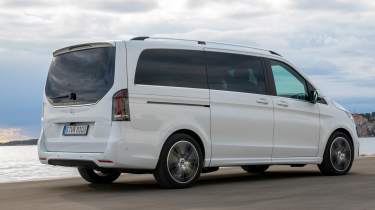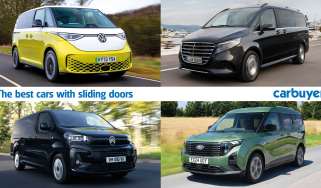Mercedes V-Class MPV - Engines, drive & performance
The Mercedes V-Class shows its van roots, but it's fairly comfortable and the engines feel powerful
It’s hard to compare the Mercedes V-Class to rivals such as the Ford Galaxy or Citroen Grand C4 SpaceTourer because while they’re almost as big, they’re also designed to be MPVs from the outset.
The V-Class is based on the Mercedes Vito van, and as such brings compromises, although not as many as you might think. On the move, the V-Class's rear suspension has a tendency to crash over bumps in the road, but with some passengers in the back seats, it smoothes out the worst road surface imperfections well and we found the long-wheelbase version most comfortable of all.
The Mercedes’ steering system is very light and much slower to react than models like the Ford S-Max – another hangover from the V-Class’s humble roots. The standard-fit Agility Select system, which can adjust the car’s suspension and steering to offer a more relaxed, more sporting or more efficient drive.
However, few will buy a V-Class as a toy – this is a model that’s more likely to be seen outside posh hotels, golf clubs and airports than the school gates, so to criticise it for not being fun is rather unfair. For what the V-Class has been designed for, it is very good.
More reviews
In-depth reviews
Road tests
If you want the Marco Polo camper van, the implicit extra weight of the conversion means it’s a little slower, softer and less responsive than the standard V-Class, but it’s easy to drive and quiet once you’re cruising.
Mercedes V-Class diesel engines
The latest Mercedes V-Class gets the same power options as before, comprising a 163bhp and 236bhp version of the 2.0-litre diesel, badged 220 d and 300 d respectively. When we drove the 300 d we found it to be a little harsh at low speeds, especially under acceleration, but with plenty of grunt and a responsive nine-speed automatic gearbox that changes up before the engine can get too loud, refinement isn’t bad.
At motorway speeds the V-Class quietens down considerably, making it a great cruiser. Because there’s very little between them in terms of fuel economy, we’d recommend springing a little extra for the 300 d over the 220 d for the extra power that it offers.
While drivers are unlikely to test its 0-62mph time of 7.9 seconds very often, its mid-range punch does come in useful, especially when the V-Class is fully loaded with passengers and luggage.
Still, the V 220 d will likely be powerful enough for many, though, especially if most journeys are to be undertaken around town, with less high-speed driving, so it’s still worth considering.
Mercedes V-Class petrol engines
There’s not yet a petrol variant of the Mercedes V-Class, but the brand will be introducing a mild-hybrid petrol later down the line. We’ve tested this in prototype guise and are happy to report it was smooth and quiet – in many ways more in keeping with Mercedes’ ethos – we’ll reserve full judgement for the production model.










